|
A
child in the 1980's, I lived, breathed, and loved movies.
Every genre, every type…from boyhood fantasies of aliens
and adventurers courtesy of Spielberg, to somber tales
of axe-wielding fathers and war-torn battlefields courtesy
of Kubrick. (I saw FULL METAL JACKET three times when
it came out; I was a pretty intense 13-year-old.)
But
however great my experiences then - this was, after
all, the decade of Indiana Jones, Rambo, halfway
decent Star Wars sequels, Back to the Future,
Ghostbusters, and a pre-nippled Batman -
I think what excited me most, whenever stepping beneath
that local town center theater marquee, was the chance
to see the latest round of movie posters.
An
important clarification: when I say "movie poster",
I'm not referring to the photo-touched, photoshopped,
photodigital photocrap that's become the norm these
days, slick and stylish though some may be. I'm talking
about real movie posters - the big, artful, sometimes
cheesy, often delightful product of some guy who actually
sat down behind a drafting table and put a sharpened
pencil to paper.
That's
pencil, I said now. Not pixel.
It's
probably the toughest art to master for any illustrator.
It's not just about getting the actors' likenesses right;
it's about conveying the best and most enticing things
a movie going experience can offer -- it's soul,
if you will -- even if that sounds a bit inflated
when so many films out there are such soulless enterprises.
Most
poster artists rarely get the chance to see the very
films they're slaving over prior to finishing their
work. Commissions often come at the very last minute,
with deadlines fast approaching. (A rather inexcusable
crime on the studios' part, when one considers the inordinate
amount of time they waste gestating their projects.)
It's
a tough job, and poster artists are a rare breed.
|
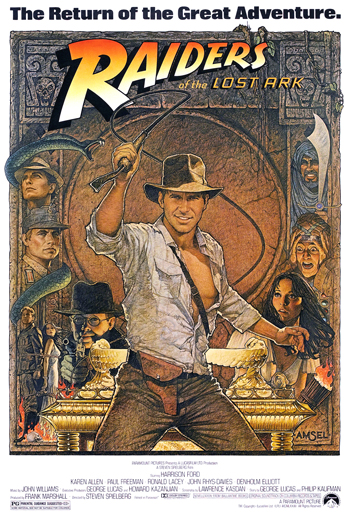
Have
whip, will travel: Poster for RAIDERS' 1982
re-release, featuring Amsel's trademark montage
illustration style.
|
For
me, "masters" like Bob Peak, Drew Struzan and Roger
Kastel deserve to be held in the same regard as classic
illustrators like Norman Rockwell, Maxfield Parrish
and N.C. Wyeth. Why? Because at their best, their work
didn't just convey the highlights of a movie coming
soon to a theater near you, but rather they built upon
the anticipation, the promise and excitement of what
(hopefully) was in store…hinting just enough to whet
our appetites, while not spoiling things by giving too
much away.
Toggle
through some of the pages on my site and it will come
as no surprise that RAIDERS OF THE LOST ARK is my favorite
film of all time. But it also has my favorite movie
poster of all time.
Look
at this poster at right, used for the film's re-release
in 1982. I challenge anyone to so perfectly capture
a film's spirit within a single drawn image.
It's
not just that the actors' likenesses are good; here,
they take on a larger than life quality -- epic, heroic,
even cartoonish, but all in the most wonderful, high-spirited
way imaginable. Like the film itself, this poster evokes
the grand, stylish, and cheesy fun of 30's and 40's
adventure serials, while executed with far more sophistication
and visual panache.
Simply
put, this poster is the movie, and I've been
a fan of both ever since.
Of
all the American illustrators of the 20th Century, there
are two whose work I have admired the most. The first
is Joseph Christian Leyendecker. The second is Richard
Amsel.
These
men lived and worked decades apart, and their experiences
were far removed from each other. Leyendecker, born
in Germany in 1874, trained in Chicago and Paris, and
produced literally hundreds of works of enormous influence
and popularity, most notably his covers for The Saturday
Evening Post and his advertisements for "The
Arrow Collar Man".
Before
Rockwell (with whom the artist had both a close friendship
and career rivalry), Leyendecker was the
great American illustrator, and his career spanned over
half a century.
Amsel's
career lasted fifteen, a life cut short by the AIDS
epidemic. He was 37 years old.
Yet
I don't think it's outlandish to make a comparison between
these two men. To say that they were extremely gifted
is all too obvious; both Leyendecker and Amsel were
something of art prodigies, and both began their respective
careers at a very young age. In Leyendecker's case,
it is said that his talent, while studying at the Chicago
Art Institute, was already so sophisticated that his
art instructors didn't know what was left to teach him.
(Or perhaps Leyendecker felt they had too little to
contribute.) In similar fashion, Amsel's career took
off while he was still a mere student at the Philadelphia
College of Art. When 20th Century Fox sponsored a nationwide
poster contest for their big budgeted Barbara Streisand
vehicle, HELLO DOLLY, it was Amsel's design that took
the prize; the artist was then a ripe old age of 22.
On
a personal level, perhaps it's because both Leyendecker
and Amsel strike me as enigmas that I find them so intriguing.
Little is known (or at least has been made public) about
their private lives, and, however great their success
during their respective careers, neither name is quickly
recognized by the public … an especially peculiar, bittersweet
fact when compared to the enduring popularity of their
work.
Of
Leyendecker, this we do know: he was gay, had a lifelong
partnership with Charles Beach, a man who served as
the artist's model, caregiver, and business "agent"
of sorts. Leyendecker remained intensely private about
their relationship, and grew increasingly reclusive
after the death of his brother, Frank, in 1924.
(Frank
was a gifted artist in his own right, though he reportedly
often struggled with living in the shadow of Joseph's
towering success.)
I
mention Leyendecker's sexuality not to incongruously
dwell on the topic -- the question of how much an artist
need be revealed when discussing his art is another
matter entirely -- but to put his life in historical
perspective. Leyendecker kept his personal life private
because, understandably, social attitudes of his day
dictated he do so. But so extreme was his need for secrecy
that only a handful of photographs of the man still
exist; Beach, apparently acting on Leyendecker's instructions,
burned many of them upon the artist's death in 1951,
along with virtually all of their personal writings.
In
fact, most of what we know today about Leyedecker's
life has been from Norman Rockwell, whose early work
was so influenced by the elder artist's that Rockwell
devoted an entire chapter to him in his autobiography.
As
for Amsel's private life, I feel no need, nor find it
in good taste, to besmirch it in any way simply because
the man had AIDS. Thousands did then. Millions do now.
The virus' only relevance for my discussion here is
that it robbed us of a superlative talent, and all the
glorious, wonderful work that could have been.
|

For
THE STING's movie poster (detail right, 1973),
Amsel's design paid homage to the painting syle
of J.C. Leyendecker, and evoked both Leyendecker's
"Arrow Collar Man" (left) and his beloved
Saturday Evening Post covers. Leyendecker's
technique is extremely difficult for even skilled
painters to emulate; Amsel was in his mid twenties
when he did it.
|
The
dearth of available information on Amsel, the man, always
seemed odd to me, as his career in the seventies and
eighties was relatively recent. Surprising, too, is
the almost complete lack of material on Amsel in the
two places I had most expected to find them: the Motion
Picture Academy Library in Beverly Hills, and the Philadelphia
College of Art, where Amsel studied.
His
obituary in Variety seemed cruelly brief, even
fleeting. It opens, "…illustrator for numerous Hollywood
film print campaigns as well as portrait artist for
many TV Guide covers, died Nov. 17 in New York of pneumonia,
it has been learned."
No
tributes, no thoughtful eulogies or tender reflections.
Of Amsel's family, it merely stated that he left behind
his parents, a brother and a sister.
Why
does this affect me so? What is it about Amsel's work
that I find so remarkable? Why should I wonder so much
about the man, and look back on his career with such
poignance, even tenderness?
BIOGRAPHY
Richard
Amsel was born in Philadelphia on December 4, 1947.
He attended the Philadelphia College of Art, and, thanks
in no small part to his winning HELLO DOLLY illustration,
quickly found enormous popularity within New York's
art scene.
The
key to his success, beyond raw talent, was the unique
quality of his work and illustrative style. Amsel could
perfectly evoke period nostalgia (his posters for THE
STING and westerns such as McCABE AND MRS. MILLER come
to mind), while also producing something timeless and
iconic, perfectly befitting both something old and something
new. And however different his approach from one assignment
to the other, all would bear his instantly recognizable
stamp. Not to mention a damn cool signature:

"Amsel's
work usually pays affectionate tribute to the past,"
one critic stated. "His style, however, is timeless
and his attractive use of warm, glowing colors adds
an even greater 'modernity' to his evocations of times
and styles gone by."
Amsel
himself said, "I'm interested in uncovering relationships
between the past and the present, and in discovering
how things have changed and grown. I don't see any point
in copying the past, but I think the elements of the
past can be taken to another realm." Such was the case
with an early commission from RCA Victor, who asked
the artist to create new artwork for their remastered
recordings of Helen O'Connell, Maurice Chelalier, and
Benny Goodman.
Amsel's
illustrations then caught the attention of a young singer/songwriter
named Barry Manilow, who at the time was working with
a newly emerging entertainer in cabaret clubs and piano
bars. Manilow introduced the two, and it was quickly
decided that Amsel should do the cover of her first
Atlantic Records album.
You
could say it was a sure Bette.
The
artist's cover for Bette
Midler's The Divine Miss M presented the 5'2"
entertainer as a sort of natural-born icon, and one
would be hard pressed to argue that Amsel's subject
didn't deserve such treatment.
More
album covers soon followed, along with a series of magazine
ads for designer Oleg
Cassini, but it's Amsel's portraits of the fire-haired
diva that remain the most popular.
|

Bette
Midler
(2)
1973
Acrylic and ink on board
30 x 23 1/2 in.
|

Bette
Midler -- Clams on the Half Shell
(2)
Oil on canvas
29 7/8 x 30 in. |
Amsel
continued illustrating movie posters, and for some of
the most important and popular
films of the 1970's: THE CHAMP, CHINATOWN, JULIA, THE
LAST PICTURE SHOW,
THE LAST TYCOON, THE LIFE AND TIMES OF JUDGE ROY BEAN,
McCABE & MRS. MILLER, THE MUPPET MOVIE, MURDER ON THE
ORIENT EXPRESS, NASHVILLE, PAPILLON, THE SHOOTIST, and
THE STING among them. (The latter's
poster design paid homage to none other than Leyendecker.)
Though
brief, Amsel's career was certainly prolific. By the
decade's end his movie posters alone matched or exceeded
the creative output of many of his contemporaries. Yet
Richard Amsel was
far more than just a movie poster artist.
|
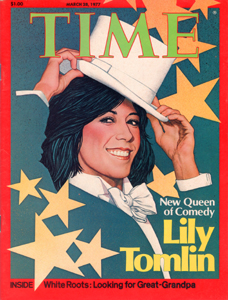
Talk about a killer deadline! Amsel's cover art
for TIME, featuring Lily Tomlin, was created in
only two or three days. It is now part of the
Smithsonian
Institution's permanent
collection.
|
His
work graced the cover of TIME -- a portrait of
comedienne Lily Tomlin, now housed in the permanent
collection at the Smithsonian Institution in Washington
D.C. In keeping with the magazine's stringent deadlines,
Amsel's illustration was created in only two or three
days.
LONG
ASSOCIATION WITH TV GUIDE
In
1972, TV Guide commissioned him to do a cover
featuring the Duke and Duchess of Windsor, coinciding
with a telefilm about their love affair. Thus began
Amsel's thirteen year association with the entertainment
magazine, resulting in 37 published covers -- a
record Amsel holds to this day. (Not unlike Leyendecker's
record for The Saturday Evening Post.)
The
"Amsel covers", now prized collector's items,
feature portraits of such figures as Mary Tyler Moore,
John Travolta, Elvis Presley, Ingrid Bergman, Johnny
Carson, Tom Selleck, Nancy Reagan, Frank Sinatra, Princess
Grace and Katherine Hepburn. Particularly notable issues
include Clark Gable and Vivian Leigh for GONE WITH THE
WIND's television debut, the wedding of Prince Charles
and Lady Diana, and Richard Chamberlain for the miniseries
SHOGUN.
Yet
perhaps the most beloved is Amsel's portrait of Lucille
Ball, done for the magazine's July 6th, 1974 issue honoring
the comedienne's retirement from series television.
"I
did not want the portrait to be of Lucy Ricardo," Amsel
explained, "but I didn't want a modern-day Lucy Carter
either. I wanted it to have the same timeless sense
of glamour that Lucy herself has. She is, after all,
a former Goldwyn Girl. I hoped to capture the essence
of all this." Amsel's
work so impressed Ms. Ball that the artwork was later
prominently featured in the opening credits of a two-hour
television tribute, CBS Salutes Lucy: The First 25
Years.
Years
later, representations of Amsel's covers were placed
on exhibit at the Museum of Television and Radio in
Beverly Hills, commemorating TV Guide's fortieth
anniversary.
|

For
this opulent cover featuring Shogun, Amsel
took inspiration from the bold lines and vivid
colors of Japanese art. For the original painting,
he employed actual gold leaf on the clouds in
the background. (5)
|
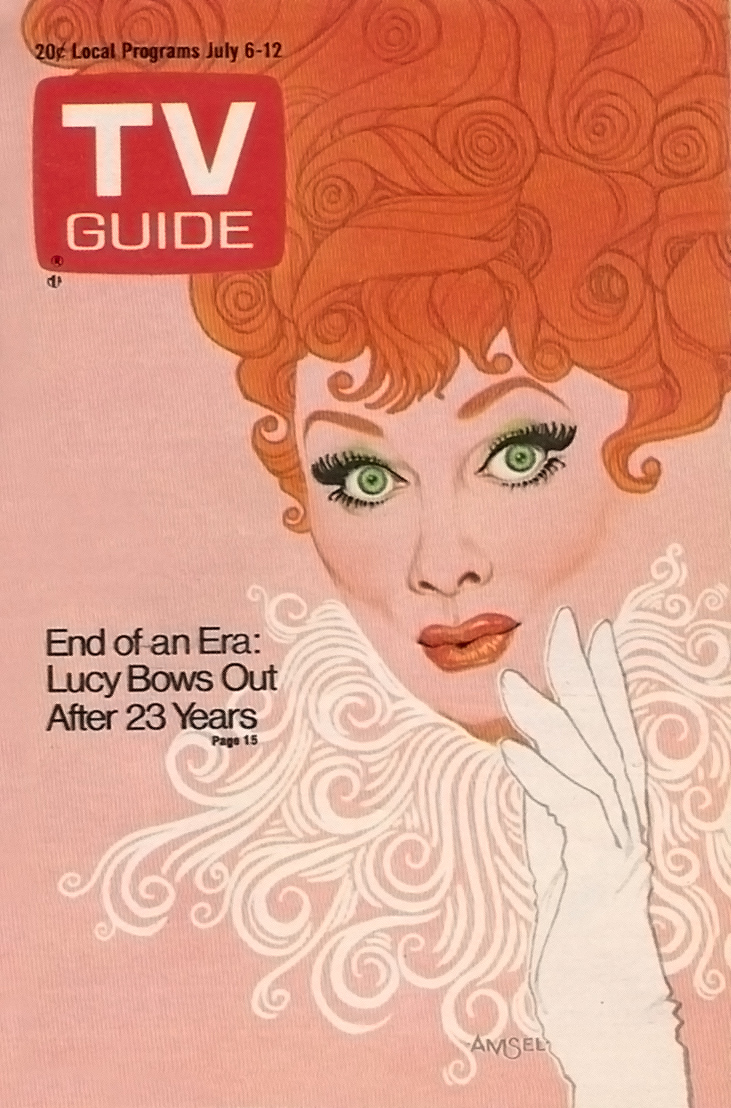
Perhaps the most beloved of all his TV Guide
covers, Amsel's illustration of Lucille Ball honored
her overall "timeless sense of glamour"
rather than referencing a specific period. (5) |
THE
1980's
The
1980's marked a dramatic change in movie marketing campaigns,
with more and more employing photographs in favor of
illustrations. Movie poster artists now faced a narrower
field in which to compete, often limited to science
fiction, fantasy, and adventure films. The old masters
like Bob Peak -- whose bold, striking campaigns for
CAMELOT, STAR TREK, SUPERMAN, and APOCALYPSE NOW helped
redefine the very nature of movie poster art -- seemed
increasingly dated in their style, and had to make way
for a new generation of artists (notably Drew Struzan).
|

TV
Guide: Oct. 26-Nov. 1, 1985
(4)
The final work of art completed by Richard Amsel.
He died less than three weeks later, on Nov. 17,
1985. He was 37 years old.
|
Yet
Amsel remained productive, his trademark signature becoming
a widely recognizable fixture on further magazine covers
and movie posters, including such high profile, "event"
films as the colorful, campy FLASH GORDON, the elaborate
fantasy THE DARK CRYSTAL, and - of course - that action/adventure
film with a grandstanding name, RAIDERS OF THE LOST
ARK.
Amsel's
output garnered numerous awards, from the New York and
Los Angeles Society of Illustrators, a Grammy Award,
a Golden Key Award from The Hollywood Reporter, and
citations from the Philadelphia Art Director's Club.
His
last film poster was for MAD MAX BEYOND THUNDERDOME,
the third of George Miller's apocalyptic action movies
with Mel Gibson. His final completed artwork was for
an issue of TV Guide, featuring news anchors
Tom Brokaw, Peter Jennings and Dan Rather.
GONE, BUT NOT FORGOTTEN
Amsel
died less than three weeks later, on November 17, 1985.
When
he fell ill, he was to have done the poster for the
ROMANCING THE STONE sequel, THE JEWEL OF THE NILE.
It's
been over two decades since Amsel's passing, and in
that time we've also said farewells to Bob Peak, Birney
Lettick, and John Alvin. (Alvin died of a heart attack
hours after this article was completed.) Peak's
sons, including artist Matthew Joseph, maintain
an online archive of their late father's work, and are
currently developing a book of his movie poster illustrations.
Alvin
and Struzan also have their
own respective websites, with the latter -- now the
leading figure among today's successful poster artists
-- having two extensive books already published chronicling
his career and work.
Yet
what of Amsel's legacy? While his art continues to amaze
and inspire, little has been said about the man himself.
I figured surely someone, somewhere in the world was
willing and able to speak for him.
Thankfully,
I was right.
In
researching this article, I came across some rare sketches
Amsel did in preparation for his RAIDERS posters. Having
never seen them before, I asked their owner how she
came to acquire them. Thus began a conversation that
led me to many of the answers I'd been searching for.
PERSONAL
REMEMBRANCES
Dorian
Hannaway is the director of late night programming at
CBS Entertainment. For years she has been the champion
of Amsel's work, fighting to get his name better recognized.
She also owns many of Amsel's original pieces. But to
call her a collector is inaccurate, for Hannaway's interest
was -- and remains -- a very, very personal one.
She
first met Richard Amsel in 1974, and the two struck
up a close friendship that lasted until his death. Perhaps
it lasts still, for while we discussed the artist at
length, Hannaway often tenderly referred to him as "My
Richard." It was clear to me that she is still wounded
by his absence.
|
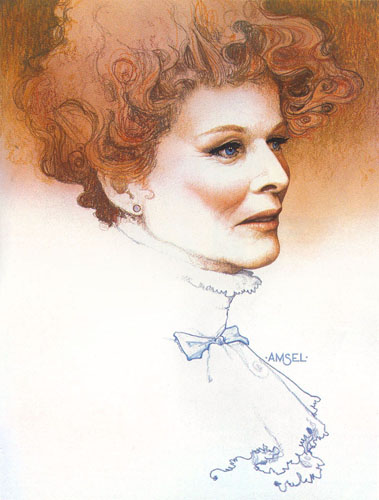
TV
Guide: Jan. 27, 1979 (11)
Amsel's portrait of Katherine Hepburn is one of
my personal favorites.
|
"No
one, no one ever worked as hard as Richard," she said,
almost forcefully, in our first phone conversation.
Her knowledge led me to better appreciate the man, as
well as the artist I'd idolized. Hannaway, in fact,
conducted one of the few known recorded interviews with
Amsel, a profile of the artist for Emerald City,
a cable access show. Made in 1978, Amsel described his
work on the poster for the motion picture DEATH ON THE
NILE.
Among
their circle of friends were Jerry Alten, the art director
of TV Guide, and artist David Edward Byrd.
Byrd
is celebrated for his work featuring Jimi Hendrix, The
Who and their rock opera TOMMY, the commemorative poster
for Woodstock, and countless Broadway and Off-Broadway
shows. (His poster for GODSPELL is especially famous.)
He, too, was eager to share his recollections of the
late artist.
Amsel,
I would learn, was someone who was warm, gracious, and
full of life -- a handsome young man, stunningly gifted,
who surrounded himself with good friends, and was receptive
to and reciprocating in his friendships. But he was
also a complex man who, as is the case with many artists,
clung to his privacy and kept a great deal to himself.
"Richard
was an odd man," Byrd said, his tone far more affectionate
than in any way critical. "I called him the
savant. He was this genius, but had trouble negotiating
life in a bad way. He had no taste in clothes, but his
taste in art was impeccable. ... He wore the same outfit
everyday: a plaid shirt and bluejeans. I asked him if
he wore the same things all the time, or just had a
thousand copies of them! ... (Yet) he was vain in the
way he looked. He was very handsome, but he would never
wear his glasses -- he didn't like the way they looked
on him! So he couldn't see, he was almost blind!"
I
asked Byrd if he considered Amsel something of a social
misfit. He agreed, believing the description accurate.
He added in an email:
Richard
and I got on very well. We loved to talk with each
other about everything -- sometimes we would be
on the phone for five hours -- art history, artists,
technique, boyfriends, 3-strip technicolor, gossip,
pop culture, drugs, Nathalie Kalmus, Pete Smith,
pencils, Earl 'The Pearl' Moran, Film Noir, etc.,
etc...
I
went to California for the first time with Richard
and Dori -- Richard and I had just delivered TV
Guide covers to Jerry Alten the day before (John
Travolta by Amsel and Robert Conrad by myself).
We made a lot of Super-8 movies together. I was
Richard's date at the big TV Guide banquet at the
National Portrait Gallery in Washington, DC. It
honored both the subjects and their artists. I remember
we were at the table with Julia Child and Henry
Kissinger. We stayed in a seedy hooker hotel not
far from the event. We made a long movie about that
trip, which is pretty amusing!
In
describing Amsel's personality, both friends emphasized
the artist's sharp, droll style of humor. "He was very
silly, very funny," Hannaway said. "No one
had a sense of humor like he had." Byrd laughed, "He
had no social skills, but he had a stringent wit."
In
addition to his drawing abilities, Hannaway said that
Amsel was quite the skilled photographer. Working with
the late gay activist and writer Vito Russo (co-founder
of GLAAD and author of The Celluloid Closet),
Amsel contributed photographs to articles published
in The Advocate magazine.
SCHOOL
DAYS
After
this article was originally published, I was contacted
by other people willing to share some of their personal
recollections of Richard Amsel. Among them was one of
his classmates at the Philadelphia College of Art, Rhonda
W. Gross. Even in those early school days, Amsel's abilities
-- as it had been with J.C. Leyendecker -- were easily
apparent. Gross wrote in an email:
It
was obvious from the first weeks that he was a special
person, a generous spirit and worth watching. It
was an amazing class, that group from 1965 to 1969.
Many of us went on to become teachers as well as
practicing artists. Richard was so advanced that
many of our professors were intimidated by him.
They need not have been, as he was a gentle soul
who was generous with his methods and techniques.
I was a rapt observer, believe me. ...
Richard
was so amazingly ahead of the rest of us in so many
ways. His technique was fearless experimentation
with materials and techniques that we would wonder
how the art projects were going to work. Somehow,
they always did and we expanded our knowledge base
by watching him, sometimes to the consternation
of our professors.
Through the years I would see examples of his work
in the commercial art sector, and I was personally
honored to have known such a talented person.
TAKING
NEW YORK BY STORM...IN A TINY APARTMENT WITHOUT AN EASEL.
Another
person who contacted me was Michael Danahy, who met
Amsel in 1971 shortly after moving out to New York from
L.A. Both
men were only in their early twenties at the time, but
by even then, Danahy was amazed at Amsel's talent and
reputation.
"We
met at upper east side bar," Danahy said, noting
that Amsel didn't like to travel to the other side of
the city. "I think he thought it was beneath him,"
he laughed.
Yet
Amsel's own living accomodations back then could hardly
be deemed extravagant. They definitely weren't spacious.
"It
was smaller than most motel rooms," David Byrd
chuckled, remembering Amsel's Manhattan pad. "It
was maybe 400 square feet ... it had a tiny kitchenette.
I could probably do a drawing of what it looked like.
... He had an apartment in a luxe door-man high-rise
on the Upper East Side. ... Even when he moved out to
L.A., he always had to have a doorman!"
Dorian
Hannaway recalled how Amsel owned his own prints of
several classic Disney animated films, and would invite
people over to watch them. "He had a little one bedroom
apartment up on East 83rd Street, and would project
CINDERELLA on the wall."
|
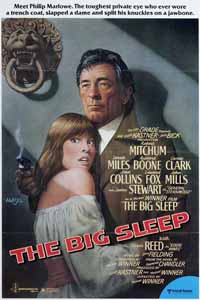
The
Big Sleep
(3)
1978
Watercolor, acrylic, colored pencils, airbrush
on board
22 7/8 x 16 in.
|
"Richard
kept all his art supplies in a cardboard grocery box
under the bed," David Byrd said. "His bed
was like a narrow cot that could
hold one person barely. Next to that was a 35mm projector
for his vast collection of 3-strip Technicolor prints
of everything worth seeing in that medium, from GONE
WITH THE WIND to COBRA WOMAN. He had a hole cut in the
wall of the bedroom so he could project the films on
the opposite living room wall. We had movie nights at
least twice a month, it seems."
The
sparse living arrangements remain vividly within Michael
Danahy's mind. "Richard lived on those stawberry
pop tarts," he said. "He never left his apartment,
especially when he was working. Everything was disorganized.
He had this little bedroom off to the left, and always
hid his paintings whenever guests came over."
This
latter fact, Danahy explained, hinted at the artist's
extreme privacy whenever his work was concerned. "He
was really hesistant to show anything until it was in
the form in which it was intended. He'd never let anybody
watch him paint."
That
is, almost never -- for Danahy recalls one occasion
when he had the rare opportunity to see his friend at
work. "I had to crash at his place one night because
I couldn't get home. Richard had a deadline. ... He
was always late, always disorganized, always started
the night before, always up all night, sitting on his
very 70s sofa with the canvas balanced on his knees..."
"His
knees?" I asked, not quite believing
I'd heard Danahy right.
I
had. Such a revelation filled me with creative shock
and awe. It
seems unthinkable that Amsel, who, having already established
himself with several major motion picture campaigns,
not only lived within such a tiny space...but was an
artist without an easel.
David
Byrd wrote:
Probably
the most amazing thing that people do not know about
Richard was his working habits. Richard worked on
his little glass dining table with the cardboard
box of Prisma Pencils, frisket, etc., on the floor
beside him. He never allowed anyone to see him work.
He was truly a 'savant' in that he could create
a gorgeous piece almost anywhere. ...
He came to my loft very often. I had a 5000 square
foot place in Chelsea, right off 5th Avenue at 17th.
He often shot photos for his jobs at my loft. For
instance, with THE BIG SLEEP, I stood in for Robert
Mitchum and my assistant, Amy, was Candy Clark.
THE DIVINE MISS M
|
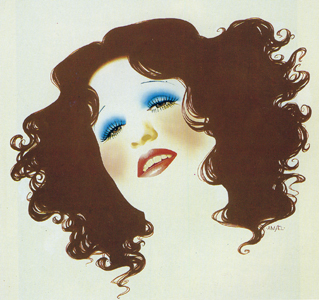
The
Divine Miss M
(2)
1972
Watercolor, acrylic and colored pencils
14 x 14 1/2 in.
|
Michael
Danahy described how Amsel's creative influences were
often a mesh of art, personalities, and pop culture.
"Richard's most favorite subjects were famous women
and iconic gay characters. He was fascinated by them.
… He did the Bette Midler portrait because he wanted
to meet her. … He was courting her, but she was also
courting him."
That
courtship, as Danahy described it, began while Midler
was at the start of her career, making a name for herself
by performing in nightclubs and to packed audiences
at gay bathhouses (the latter earning her more cheerful,
endearing renown than sordid infamy).
"I
took him (Richard) to see Midler perform at Carnegie
Hall," Danahy said. "She was incredible … then we all
went to a party afterwards and everyone was on drugs.
But Bette Midler wouldn't even smoke a joint, when all
the rest of us did! … They were crazy times."
It
was Barry Manilow who introduced Midler to Richard Amsel,
and, their courtship sealed, the artist set off to do
the cover of Midler's debut album. That proved to be
a watershed moment in Amsel's career, and Danahy managed
to witness it firsthand.
He
recalled his curiosity over how the final portrait was
going to look: "I asked him what the cover was going
to look like, but Richard was still working on it and
didn't want to show me. Instead he grabbed a napkin
and drew Bette Midler's face. And that was it, her face
was immediately captured down on that sketch."
Amsel
and Manilow were good friends, Danahy said, but there
was a strained moment between them when Manilow, by
then readying an album of his own, asked Amsel to do
the cover -- and was denied. "Manilow was really upset
over that," Danahy said, and explained how Amsel, because
he was always working, had times when he needed to be
selective about the projects he worked on.
EVER
THE STRUGGLING ARTIST
|
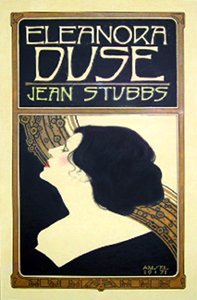
Elenora
Duse
1971
Size and medium unknown.
|
Danahy
added: "Richard struggled a lot (back then), and would
put things off because -- and I know this sounds strange
-- because he felt he worked best doing everything all
at once. I ran into him one time and he was stressed
out about finishing a project. I asked him, 'Why aren't
you working on it now?' and he said, 'I just can't work
that way… I need to wait.'"
And
however lucrative Amsel's commissions may have been,
Danahy tellingly added that Amsel's head for financial
matters was similarly remiss. "Richard had an agent
and worked with Society of illustrators in New York,"
he said. "He'd make around $5000 a poster in the early
seventies. ... that was a hell of a lot of money in
those days. … But he spent money as quickly as he earned
it. … It's not that he was deliberately indulgent or
extravagant, he just could never hold on to his money."
Danahy
recounted an oddly humorous tale regarding a Barbra
Streisand portrait Amsel had painted in the style of
Gustav Klimt -- which was stolen while on exhibit at
the Philadelphia Art College. "The painting was gorgeous,"
he said. "I was shocked when I found out, and I asked
Richard if he was okay. I thought he'd be so upset,
but instead he laughed ... he was compensated $147,000,
and was thrilled! He told me, 'God, I hope they don't
find it, otherwise I might have to give all that money
back!'"
Danahy
admits that he lost touch with Amsel after 1973, but
values the close friendship they had during their few
years together. Now a film producer in Los Angeles,
Danahy
is also a proud owner of one of Amsel's original pieces
- a paperback book cover illustration for Eleanora
Duse, given to Danahy by the artist himself.
"He
was planning to throw it out to make more room in his
apartment," Danahy said, "so I asked him if I could
have it." Ever the bargain hunter for films to show
on his beloved movie nights, Amsel offered Danahy the
painting in exchange for some of his Disney reels. Today,
Eleanora Duse remains framed and on display within
Danahy's home.
THE ARTIST'S TECHNIQUE
|

Amsel's
painting for THE SHOOTIST, John Wayne's final
film, incorporated gold paint on the background
even though its shimmering effect couldn't be
reproduced on the posters. (2)
|
I
asked Dorian Hannaway about Amsel's painting technique,
for however familiar I may have been with the artist's
work, I'd yet to see many images chronicling his creative
process. It's one thing to see a finished piece, but
quite another to see how it all started.
Amsel
worked with all sorts of mediums. He frequently used
thin glazes of acrylic, like washes of watercolor, and
then applied colored pencils and pastels. He'd then
go back and forth, combining them little by little,
layer upon layer, until the piece was completed to his
satisfaction.
Sometimes
his methods were more exotic. For his illustration on
THE SHOOTIST, Amsel used gold paint to accentuate the
background, even though printing limitations prevented
its shimmering effect from being accurately reproduced.
For McCABE AND MRS. MILLER, the artist's "canvas" was
an actual piece of wood, keeping in the style of the
period western.
PRESERVING AMSEL'S LEGACY
When
I first met with Dorian Hannaway at CBS, my eyes lit
up upon entering her office. Amsel's posters dominate
the room - each one tastefully placed, beautifully framed.
There was also an original piece - a curious, three-sided
block of wood Amsel painted as part of a promo for the
film THE LAST OF SHEILA. I held the thing in my hands
and was stunned by the level of detail -- so good that
it was as if Amsel had painted it five times its actual
size, then glued shrunken photographs of the artwork
to each side. The greedy little kid in me was tempted
to steal it.
Hannaway
took out a large, handmade three-ringed binder, an impressive
thing several inches thick. She opened it to reveal
a chronological archive of Amsel's work. The book itself
seemed to be a labor of love -- Hannaway's prized possession,
her own little Holy Grail or Ark of the Covenant. I
could hardly blame her, for as we sat on the couch flipping
through the pages I was transfixed by the images I saw.
|

Poster
for RAIDERS OF THE LOST ARK's American release
in 1981. George Lucas owns the original Amsel
art, while Steven Spielberg owns the re-release
illustration.
|
There
were pages, many pages, of Xeroxed pencil sketches,
of color photocopies, of art comps and studies. Some
were simple thumbnail sketches - tiny things Amsel loosely
whipped up on the fly; seeing them was like stepping
through a doorway to his mind. Other colored sketches
were quite detailed - so good, in fact, that they could
have easily made for impressive final designs.
There
was a copy of a GQ cover Amsel
painted in the style of Gustav Klimt, a glorious thing
the Austrian might have done himself. There were sketches
of Richard Chamberlain in samurai garb, studies for
the TV Guide SHOGUN issue; Hannaway shared that
Amsel used actual gold leaf for the final illustration.
Most
of this I'd never seen before in any form. They included
designs for such films as CUBA, KRULL, SAHARA, and GREYSTOKE
-- poster campaigns that Amsel didn't get. Even
the most talented runners can still lose a race, and
I realized that however much success he enjoyed, Amsel
still had to fight like hell to get each job.
Byrd
later confirmed my feelings, adding: "Richard never
did art for his own pleasure. He needed to be paid."
Hannaway
showed me Amsel's RAIDERS comps. The
first sketch was a quick pencil rough - a tiny image
of Harrison Ford, whip in hand, with small circles standing
in for what two or three characters would be. Yet even
in this early form, Amsel's layout for the first Indiana
Jones poster was almost exactly identical to the final
product.
"That
was it," Hannaway said. "Richard came up with it, just
that way. He drew Harrison Ford, and that's how it stayed
for the final poster."
The next page revealed Amsel's color composition for
the design, a second step between the tiny rough sketch
and the large final illustration. It was detailed, drawn
very much like the polished portrait, but with bolder
lines and more vivid red and orange colors. Both beautiful
and commanding, it reminded me of Bob Peak's intense
portrait of Marlon Brando, done for his eye-catching
APOCALYPSE NOW poster.
Hannaway
owns this original comp, but getting it was a task worthy
of Indiana Jones; the passage of years, and collectors'
high demand for Amsel's work, have made the artist's
original pieces very, very hard to come by.
A
TRAGIC LOSS
I
asked Hannaway if Richard's death was sudden. It was.
"He
found out he had AIDS in September, and he was dead
by late November," Hannaway said softly. By then the
disease had ravaged many in the gay community, and few
medical advancements had been made in treating those
afflicted. Rock Hudson's death happened just the month
before.
In
1985, soon after Amsel moved out to Los Angeles, Byrd
grew increasingly alarmed by his appearance. "I'd
never seen him look so thin," Byrd said. "He
was also chain smoking, and I'd never seen him smoke
before."
He
recalled their last conversation. "He said he was
going to New York and needed an operation. Then,"
Byrd sighed, "he was dead."
Michael
Danahy, too, was shocked by the news of his old friend's
death, and expressed his profound sadness over the loss
of nearly an entire generation of gifted artists and
performers to AIDS. Many other friends from his days
in New York were taken by the disease, including celebrated
illustrator George Stavrinos, with whom Danahy was especially
close. Danahy's testimony not only provides us with
a rare glimpse into Amsel's early career, but serves
as a stark reminder of the profound impact -- and tragedy
-- of the epidemic.
A
FAMILY REMEMBERS
It
would be inappropriate to ever consider this tribute
complete without hearing from members of Amsel's family,
so imagine my reaction to the following email (excerpted),
which I received in early September of 2008:
This
is Michael Amsel, Richard's brother. I just wanted
to commend you on your extraordinary web site about
my brother. What a marvelous tribute! You captured
everything about him, so accurate, so moving. No
one was more prolific or harder working than my
brother. He accomplished more in 37 years than anyone
I have ever met. He would have absolutely loved
the web site.
Anyway
… I just want to thank you again for your marvelous
work. It really brings a tear to my eye. What a
great way to keep Richard's memory alive!
Michael generously accepted my request for a phone interview,
which was followed some weeks later by a separate call
from his twin sister, Marsha Lee. Throughout
our conversations, it was clear how much they both still
held their older brother in loving esteem.
|

Photo
of Richard Amsel. (2)
|
"The
first word that comes to my mind when I think of Richard
is prolific," Michael said. "To do
what he did in 37 years is amazing. To have potential
is one thing, but to really push yourself and realize
it is another."
I
asked Michael about their childhood, and if Richard's
creative prowess was evident at an early age. "We were
very different as kids. I was always out playing, while
he was always in our room at his desk," he told me.
"When we were about six or seven, we all did those paint-by-numbers
books, and Richard's were, like, PERFECT. You'd look
at it and couldn't believe it was a paint-by-numbers.
There were no lines, it all looked like a real painting.
That showed the kind of work he was capable of."
He
described how Richard's interests and abilities intensified
through his teens. "Even when he was in high school,
he just worked endlessly," he said. "Some of his early
stuff is really amazing, and clearly foreshadowed his
greatness. … It's incredible how true Richard's drawings
were to the people in them."
Marsha
Lee described a little bit about their background. The
Amsel siblings grew up in Lynwood, Pennsylvania, and
their father ran a small clothing and toy shop in the
nearby town of Ardmore. "Mom would give Richard
these model toys and paints from the store, and he'd
be fascinated with them," she said. "I think
she was the one who gave him his very first set of paints.
"We
were a lot alike. ... People say that Richard and I
had similar expressions, in the ways we'd react,"
Marsha said. "Sometimes, back when we were kids,
after our parents would leave the house, Richard would
take Mom's makeup and do up my face. ... We both loved
glamour!"
Michael
told a story about a young girl Richard had been best
friends with during childhood. She lived across the
street from them, and was an aspiring artist herself.
When they graduated, it was she -- not Amsel
-- who won the coveted art scholarship. "It was disappointing
for him," Michael said. "It wasn't easy for our parents,
either, with all these kids in the house and going off
to college."
Ironically,
while Amsel went on to worldwide fame, Michael believes
that their childhood neighbor never established an art
career of her own.
Michael's
own son, Joseph Richard Amsel, now attends his late
uncle's almer mater, Philadelphia's University of the
Arts. "Joseph has aspirations of someday working in
film," Michael said, "and clearly has been inspired
by Richard, who he knows only from the pictures at our
home and exhibitions he has attended. Today, he has
his first illustration class at University of the Arts
… and off he goes. What were the odds of him following
Richard there?"
In
what is perhaps a bittersweet victory of sorts, Joseph
was also awarded the very same art scholarship that
had eluded Richard back when he was his nephew's age.
"I like to think of it as fate," Michael says proudly.
"It runs in the family."
He
added, "Fate, it seems, brought me to discover your
site at what was a very emotional time for me. My wife
and I just returned from taking Joseph … to Philadelphia.
... It just warms my heart to no end to see him there
because I remember how Richard came of age, with his
drawing boards and paint supplies jammed into the trunk
of a red Corvair, and his endless hours of work at home,
when he returned from classes. …
"One
of the professors I met at University of the Arts freshman
orientation last week remembered Richard coming back
to the school in his late twenties, and giving a speech.
'He was treated like a rock star that day,' the professor
said. 'The students were in awe.'"
While
Michael himself was at college, a surreal moment occurred
one day when he walked through the streets of Columbus
... and saw a familiar looking poster at a nearby movie
theater.
|
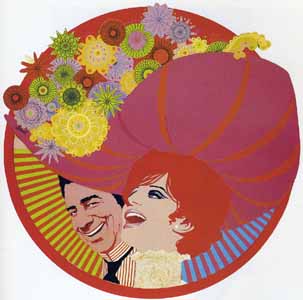
Amsel's winning design for Fox's HELLO DOLLY campaign,
1969. (The final poster can be seen
here.)
|
"I
still remember (Richard) painting the HELLO DOLLY illustration
in our room and seeing it, two years later, at a movie
house in Columbus, Ohio, when I was a freshman at Ohio
State University. It has been a lifetime inspiration
for me. It made me realize what a small world we live
in. … Dreams can become real … It really blew my mind
when I saw it.
Over
the years, Michael and Richard remained in contact,
but saw less and less of each other. While Richard's
career in art flourished, his younger brother embarked
on a career in journalism. "There was mutual admiration
between us," Michael said. "I loved journalism, and
he loved art."
Michael
remembers a time later on, after moving out to New Jersey,
that he went inside a convenience store and saw one
of Richard's TV Guide covers on sale. "He must
have done about forty of those covers -- my God, how
did he churn them out so fast? -- but seeing them, it
was through that, you knew that he was well. It was
like his way of telling us, 'I'm alright, I'm doing
okay...'"
Alas,
Michael Amsel admits that they did not have much communication
towards the end. They reunited briefly for their grandfather's
funeral -- "It was weird, with all that grief, and after
all those years," he said -- but when Richard's illness
began to get the better of him, Michael said that he
and his family were largely left in the dark.
In
the time leading up to Richard's death, Michael was
facing a health crisis of his own -- one that left both
him and his parents occupied. "I was in a hospital in
New Jersey about the same time Richard was (in another
hospital). I had a couple of broken disks, and was having
a laminectomy. I was out of work for five months, stuck
in bed. … My parents came out to visit and helped me,
but they hardly knew about Richard's situation."
Then,
late one night, came the terrible, devastating news:
Michael's mother called to tell him that Richard was
dead.
It
was as if the ground had fallen out from beneath their
feet. A shock. A tragedy. Something no parent should
ever have to hear, and no brother would ever wish to
imagine.
It
was Michael who delivered Richard's
eulogy, but it was a number of years before he truly
faced dealing with the psychological scars of love and
loss left in the wake of his brother's passing.
|
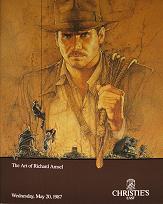
In
1987, many of Amsel's remaining originals were
auctioned off by Christie's.
|
"It
wasn't until the last eight to ten years that I really
came to terms with it," Michael said, adding that through
his work as a journalist -- by covering stories and
talking to people about death -- he finally managed
to find a form of catharsis of his own.
The
pain surrounding Richard Amsel's passing was further
complicated by the state of his unfinished financial
affairs. This led to an auction in 1987, sponsored by
Christie's, whereby a large portion of the artist's
work was put up for public sale.
Michael
sighs as he remembers it all: "The Christie's auction
… I guess it's such a mystery. So much of his work …
so unfortunate." Nevertheless, he tries his best to
put it in perspective with his brother's creative spirit.
"Richard was the quintessential artist. He was so focused
on his work that all the other things in his life just
fell by the wayside. That was the result of the genius
of the artist."
Michael
and Marsha are delighted by the enduring popularity
of Richard's work, as well as the inspiration artists
and illustrators the world over continue to take from
it. Their support of (and contribution to) this website
mean the world to me.
"Thanks
for everything you've done for Richard," Michael told
me. "You're part of Richard's renaissance."
AN
APPRECIATION
I've
always admired Richard Amsel's work, and after talking
to those who knew him, I can now admire the man. Certainly
I'd value the opportunity to hear from others who knew
him; I'd be glad to include their comments here.
David
Edward Byrd reflected in an email:
Richard
was my art hero, a true A-Team player. I always
considered myself on the B-Team, so to speak, a
modest talent with a modest success. And, oddly,
Richard Amsel is the only illustrator I have known
socially, except for my first student at Pratt Institute,
Frank Verlizzo, who became a great Broadway Poster
artist....
I
am forever in awe of his (Richard's) ability to
draw in any style. In even the tiniest sketch, the
likeness of the person is there.
Amsel's
death may have been tragic, but his life assuredly was
not. In spite of his absence, let us simply give thanks
for those magical things about him that were left to
us...
The
work.
And
what great work it is! It is silent, yet speaks volumes.
It is clever and romantic, sometimes tacky and fanciful.
It is often striking and it is always gorgeous.
Take
a look at some of the images here. Study them; imagine
how they came to be before the use of colored
pixels and stylus pens. These are not just polished
illustrations, they are true works of art...the labors
of a true artist. They've excited moviegoers and inspired
new generations of artists and illustrators. I proudly
consider myself among them.
Looking
back on his days with Richard Amsel, Byrd said, "We
lived in a time that was more interesting." The
sentiment doesn't surprise me, for interesting times,
I suspect, are largely the result of being in the company
of interesting people.
Here's
to you, Richard, wherever you may be.
Copyright
(c) 2008, 2011 Adam McDaniel.
|
|
A
few days after our phone conversation, I received
an envelope in the mail from Michael Amsel. I
opened it to find an undated sketch that his brother
had done of Marilyn Monroe. I always dreamed of
one day having a Richard Amsel original, but never
thought it'd ever come to pass. Michael proved
me wrong. Dreams, it seems, can indeed come true.
|

|